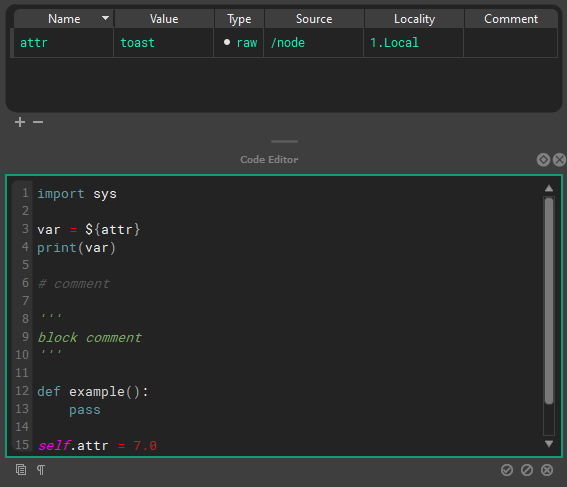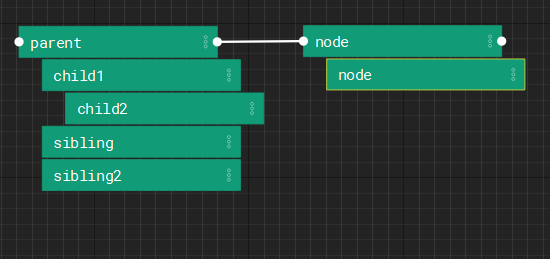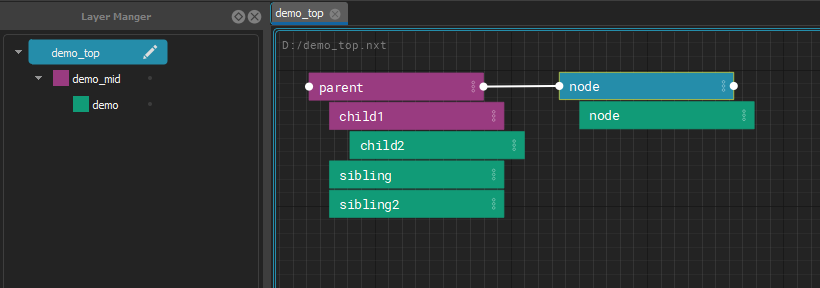Example Graphs
Checkout our example graphs here.
If you're looking for workflow checkout our workflow and transition map here.
Editors
Stage View
Node Properties
Code Editor
Layer manager
Tool Bar
Output Log
Build View
History View
Terms and Definitions
Stage
The stage is a collection of graphs, trees, and layers of nxt nodes that set the composition structure and execution order for an nxt file.
Every node has access to the STAGE object. When working with Python classes (besides the builtins) it is best to store those objects on the STAGE.
An example of how you would do that in a node's code is as follows:
my_object = ComplexData()
STAGE.complex_data = my_object
Another node later in the execution can access that object as follows:
STAGE.complex_data.a_method()
Stage attributes and composition
Note that each layer is also a node, and those nodes get composited to the STAGE object. Each node is parented to that object and inherit the attributes of it. This can be useful for defining "global" variables, or a state that needs to propagate into the entire graph.
Node
A node is a container for code (or compute) and a collection of attributes. Every node contains a single code block that is executed when a node is run. Execution order is defined both by hierarchy and connections to execution plugs on the nodes.
Attributes
Nodes contain attributes that are read from and written to from inside a node’s code block. Attributes can also be connected to inputs and outputs of other nodes via tokens in attributes, token paths within the code block, or dragging and dropping attribute connections between nodes.
At editor time (before the graph has begun executing) attribute values can be composited into other attribute’s values or into the text of a code block via ${path/to/node.otherattr}_rest_of_attr_value.
A node’s local attributes can be resolved by name alone via ${attrname}
Hotkeys
The raw/composited state can be visualized by toggling editor resolution on and off using Q, W, E.
NXT includes a full hot key editor. (Window > Hotkey Editor)
Example
The node at /path/to/node has the attribute otherattr with the value simple_stupid, and our local node has an attribute named myattr with the value never_eat
| Unresolved | Resolved |
|---|---|
| keep_it_${path/to/node.attrname} | keep_it_simple_stupid |
| ${myattr}_shredded_wheat | never_eat_shredded_wheat |
Cached view
Cached view should only be used to inspect and debug your data. It should not be considered accurate, especially if you are changing the data via the self.attribute paridigm. Any data that NXT is not confident in will be drawn with red hashes.
A node’s local attributes can be changed inside a node’s code block following python convention as seen below.
self.attr_name = 'example code'
print(self.attr_name + ' is always boring.')
While executing, the Stage can have arbitrary attributes add/set/retrieved on it, that will be available to all nodes, as seen below. Note: Inside a node’s codeblock the stage is accessed via all caps STAGE
STAGE.anyattr = 'anything you want'
print(Stage.anyattr)
Attribute connections
It is best practice to display inter-node dependencies via hierarchy or connections of attributes, rather than hide that dependency in the code. This will make your layers more portable and friendly to other users. Despite this best practice, other nodes and their attributes can be accessed inside a code block using STAGE.lookup('path/to/node') and STAGE.lookup('path/to/node.otherattr').
Tokens
A token is like a reference or pointer to another token or value. OS style pathing is used to resolve attribute and file tokens.
Attribute token syntax is ${}: if it can resolve, it substitutes the attribute, if not it will be empty.
If a token is empty it will resolve to BADRESOLVE.
${attribute}
${/absolute_node_path.attribute}
${../relative_nodepath.attribute}
File validation syntax ${file::}: this will always resolve to a real file, and will return an empty string if the file doesn't exist. Used to validate files for reading.
${file::file.nxt}
${file::C:/absolute_path/file.nxt}
${file::../relative_path/file.nxt}
File path token syntax ${path::}this will attempt to resolve to a valid path. If not, it will be empty. Used to expand paths for writing.
File path token syntax ${contents::} will include the contents of an external file. For example, ${contents::${file::external.py}} will include the contents of external.py in the attribute, compute, and it will resolve tokens written within this file.
File list token syntax ${fileslist::} will list valid historical filepaths at the same path.
Imagine you have /node.my_file = ${file::weights.json} on several layers in different directories, all saved in different folders.
If you then used a token like ${filelist::/node.weiths_file} you would get a list of file paths to the weights.json file in each of the layer's save folder.
This would allow you to collete and parse data from multiple reference layers:
all_the_data = {}
for filepath in ${filelist::/node.weiths_file}:
all_the_data.update(json.load(filepath))
File list validation
The filelist:: token only returns valid filepaths to existing files.
Relative file resolution
The ${file::} and ${path::} tokens will resolve relative paths based on the parent folder of the current display layer.
Using an external IDE
The ${contents::} token allows the use of an external IDE for authoring your compute blocks.
Tokens are not python template strings, even though they share the syntax.
Quote behavior in tokens
Since all attribute values are stored and processed as strings in NXT before they are composed as python objects, you have to manually manage string attributes. The value will substitute as written. In some cases, it makes sense to have string attributes in quotes, in other cases, it makes sense to add quotes in the code block.
For example if you had an attribute side set to a value of L
foot_${side} and 'foot_' + '${side}' are equally valid. This really comes down to convention.
There is a simple w() convenience function to assist with adding quotes when using a python string object as a string.
my_attr = 'quotes go away when it becomes a string object'
self.attribute = w(my_attr)
my_attr can now be used by downstream nodes as a string.
Compute
The compute block/code block is standard python code, with the exception that it will deep-resolve tokens over 1000 levels deep. (should this be a preference?)
Hotkeys
The raw/composited state can be visualized by toggling editor resolution on and off using Q, W, E.
numreturn or ctrl+enter or clicking off the code will accept your edit
tab and shift+tab handle multi-line indents
NXT includes a full hot key editor.(Window > Hotkey Editor)
Execution Order
Stage/Layer Node
Stub for this feature once new layer editor arrives
Execution Root
A stage can have root nodes with no parent node and no node connected to it’s input execution plug. Use execute tags to define the order
Execution Plugs
Nodes have execution plugs on their left and right to determine execution order. Nodes are executed from left to right along the execution chain specified by these connections.
Danger
We don't have checks for circular dependencies yet. So don't setup loops.
Hierarchies/Stacks
Nodes have relationships we refer to as “parent”, “child”, and “sibling” to describe their relationship to one another inside the stage to influence composition and execution order.
To begin execution from a given node, the first node is run, followed by a depth first execution of each of it’s descendants. Following the execution of the descendants, the root node whose input execution plug is connected to the current node’s output execution plug will be run following the same logic.
Stage Composition
Layers
Layers are designed to be composited (combined) to create a hierarchy of instructions that can be reused and repurposed by several NXT users for use on several assets or workflows. Multiple layers can be referenced and nxt seamlessly combines them into a single composite layer.
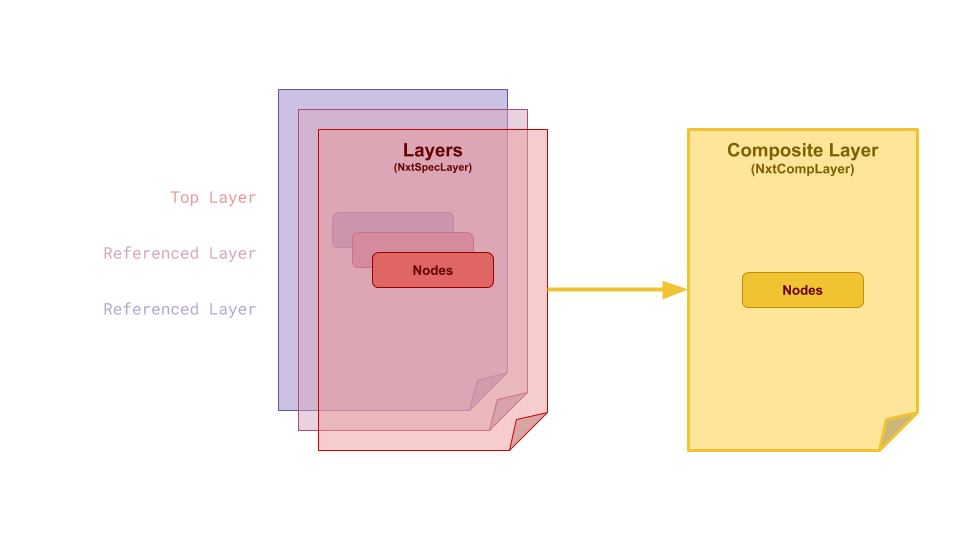
All of the layers in your file are composited together to produce final code to execute. Each layer has the power to change as much or as little as is needed to customize the composited node’s attributes and code block. These changes are stored in the file they are made on, keeping referenced files safe to use for many purposes.
Layer color propagates into nodes an also attributes.
Composition Inside Node Hierarchies
When a node is a child of another node, it inherits its attributes from that node which can be overwritten locally on the node.
Instancing
Instancing allows you to reuse nodes from other parts of the graph with specific overrides.
Instances in NXT can be simple and powerful. But they can also be extremely complicated with mind-bending edge cases. In simple terms, you can think about an instance as a clone of another node. It's like a live copy. But it's a bit more nuanced to think about an instance like an additional parent that's outside the hierarchy.
Example
- If you create a node, don't add any attributes or code, it will just look like a clone of the instance source.
- If you create a node with unique attributes it will look like the instance source is another parent. All the attributes will composite from the instance source, and the local attributes will be visible as well.

cat exists on custom_node so it's value wins.
The children of the instance node get inserted into the hierarchy as proxy children. This data exists only as a result of the composite. The are not local saved data. Proxy children are drawn in a hashed style to make it clear you haven't touched the data.
As soon as you begin to edit proxy children, they are converted into real editable nodes and exist in the hierarchy.
Note
The hierarchy has the final opinion in the composite. UNLESS the node has an local opinion on the data.
- Layer
- Node parent
- Node
- Instance parent
- Instance
Example
Build a base arm. Instance it twice. Change L to R, done.
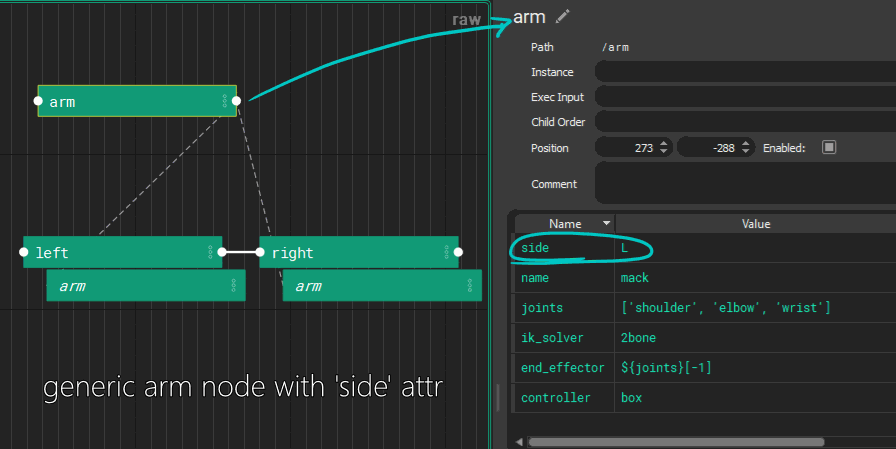
An instance of a node inherits data like a child. It creates proxy children of the instance source’s children, and can be arranged into a separate parent-child relationship as it’s instance source.
Most instance attributes are carried over. Execution input is never inherited. Child order is inherited by instances but not by children.
Data comes from the hierarchical parent as well as the instance source, with hierarchical parent having final word. Instance execution order is defined by the hierarchical parent.
Danger
If a node instances itself, or any ancestor or descendants, it will crash. It's best (because that's all thats possible) to only instance from other hierarchies or sibling nodes
NXT file spec
NXT files follow standard .json file specifications with a few specific keys in the root dictionary.
- Required:
version- str, graph version number - Optional:
alias- str, nice name for layer.
color- str, hex color.
mute- bool, mute layer when loaded as top layer.
solo- bool, solo layer when loaded as top layer.
references- list, string file paths to reference layers, ordered top to bottom (strong to weak). File paths can be relative.meta_data- dict, data about the graph not affecting its execution or composition.
nodes- dict, key of/full/node/pathand value of a node dict.
Node Dict
The node dict is what holds all the local opinions (values) about a node. All the keys are optional, however we recommend having at least 1 key and value, otherwise it is best to just delete the node.
child_order- list, strings of children node names in the order they should be executed.comment- string, think of this like a node's docstring.code- list, string lines of code that the node will run when it is executed.enabled- bool, iffalsethe node will not execute. Should be omitted from the dict unless explicitly needed as nodes with no key are assumed enabled.execute_in- str, path to root node whose hierarchy executes directly before this node's hierarchy. Only applicable on root nodes.instance- str, full or partial node path of node this node should derive its instance data from. This path should not be an ancestor, descendant, of this node nor the path of this node.start_point- bool, iftruethe node will be treated as a start node. Only applicable on root nodes.
Design Philosophy
Nobody will ever read this pretentious wall of text, but it was an important part of the development process. We hope you find it interesting, and you may find your way here if your start to dig deeper and wonder why things are the way they are.
Discovery
Nxt provides a visual map/model of user facing attributes that can be understood at a glance, and presents the code in context. This invites the user to extend and modify the functionality.
Nxt is designed around making processes and code as accessible as possible with low overhead.
-
Artists can modify attributes on code templates and learn to make code changes that would normally require a TD.
-
TD’s can establish layered templates for processes and write nodes and graphs.
-
Developers can provide Nxt ‘factory nodes’ for using their tools without writing a custom UI.
Functional/Procedural
Nxt follows a functional model. It eschews object oriented inheritance with a layer model. This allows data to be inspected on the fly and easily read.
Why not visual programming?
Nxt differs from a visual programming environment where every function (math, concatenation, data, flow control) is wrapped up in a node. Fully visual programming environments result in sprawling graphs. While the functions are readable, they are not dense. Nxt displays code standard text notation but creates a visualization for the data.
-
VP graphs can be tedious to construct. A simple operation can often require a dozen nodes but could be represented in 3 lines of code.
-
VP graphs are code under the surface anyway, so to extend the functionality, you need to write code, or construct graphs of graphs.
-
VP is a great tool for visualization of your data and flow, readability, experimentation, and discovery.
-
NXT is half visual. Half code. Seeks to keep the best parts and remove the friction for more seasoned developers.
Why not Houdini?
Houdini is a tool for building tools. It’s a visual processing engine. Can’t it do all of this already?
-
Houdini doesn’t do layering
-
Houdini is great, but maybe not the best at everything
-
Artists have decades of experience in other tools
-
Large segments of production already built around need to be built around Maya, Nuke, Unreal
-
HDA’s are black boxes and can be slow in host applications
-
PDG is great, and expensive.
Application structure

